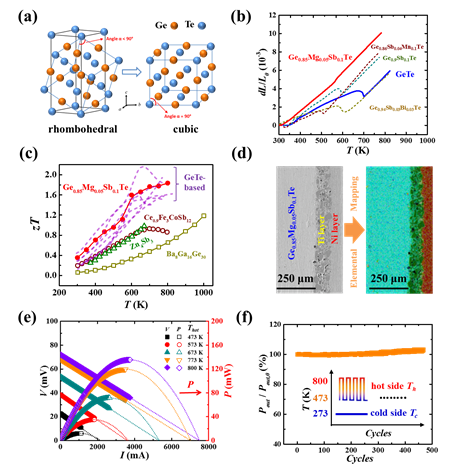New Approach to Develop Thermoelectric Materials with Superior Performance and Service Stability
The conversion efficiency of TE technology mainly depends on the material’s TE performance, which usually requires large Seebeck coefficient, high electrical conductivity as well as low thermal conductivity. However, these physical parameters are strongly interrelated, thus it is quite difficult to optimize them simultaneously.
GeTe is a p-type narrow band-gap semiconductor crystallizing with a rhombohedral structure (R3m) at room temperature. The TE performance of GeTe-based materials has been developed rapidly in the recent years. The highest ZT value has exceeded 2.0 and the theoretical energy conversion efficiency reaches 12%. In the middle temperature range, it is much higher than the classic filled skutterudites. Thus GeTe-based devices show great prospects in the application as thermoelectric generators.
By pushed the pseudo-cubic angle in the rhombohedral phase more toward 90°, the scientists from SICCAS successfully improved the thermal expansion coefficient of rhombohedral phase from 11 ′ 10-6 K-1 for GeTe to 19 ′ 10-6 K-1 for Ge0.85Mg0.05Sb0.1Te, which is close to that of cubic phase (23 ′ 10-6 K-1).
In addition, the negative thermal expansion coefficient of GeTe during the phase transition was also disappeared. Thus, the volume variation was very smooth around the phase transition temperature, which is beneficial for fabricating GeTe-based devices with high performance and high service stability.
The scientists synthesized a series of (Mg, Sb) co-doped GeTe-based compounds. (Mg, Sb) co-doping at Ge-sites also introduced additional mass and strain field fluctuations to strongly scatter heat-carrying phonons, and thus lowered the lattice thermal conductivity. The simultaneous optimization for electron and thermal transport properties resulted in a maximum zT of 1.84 at 800 K and an average zT of 1.2 at 300-800 K for Ge0.85Mg0.05Sb0.1Te.
A GeTe-based TE uni-leg was fabricated by choosing Ni as the electrode and Ti as the diffusion layer. The performance of Ni/Ti/Ge0.85Mg0.05Sb0.1Te TE uni-leg was measured. The maximum power output reach 135 mW. The internal resistance, output voltage, and power output were quite stable after even 450 thermal cycles (the hot side temperature is cycled between 473 K and 800 K). It indicated Ge0.85Mg0.05Sb0.1Te material facilitated the high service stability of TE uni-leg.

(a) Crystal structures of the low-temperature rhombohedral phase and high-temperature cubic phase in GeTe. (b) Temperature dependence of relative length variation (dL/L0) for GeTe and Ge0.85Mg0.05Sb0.1Te. (c) TE figure of merit (zT) for Ge0.85Mg0.05Sb0.1Te and some typical p-type TE materials. (d) Scanning electron microscopy (left panel) and EDS elemental mapping (right panel) performed on the interface area of the as-prepared Ni/Ti/Ge0.85Mg0.05Sb0.1Te uni-leg. (e) Output voltage (V) and power output (P) as a function of current (I) for the Ni/Ti/Ge0.85Mg0.05Sb0.1Te uni-leg under different operating temperatures. (f) Variation of relative power output (Pout/Pout,0) of the Ni/Ti/Ge0.85Mg0.05Sb0.1Te uni-leg during thermal cycling test. The inset shows the schematic map of thermal cycling test. (Imaged by SHI Xun)
Article Link:
https://academic.oup.com/nsr/advance-article/doi/10.1093/nsr/nwz052/5437694?searchresult=1#
Contact:
Prof. SHI Xun
Shanghai Institute of Ceramics
xshi@mail.sic.ac.cn



